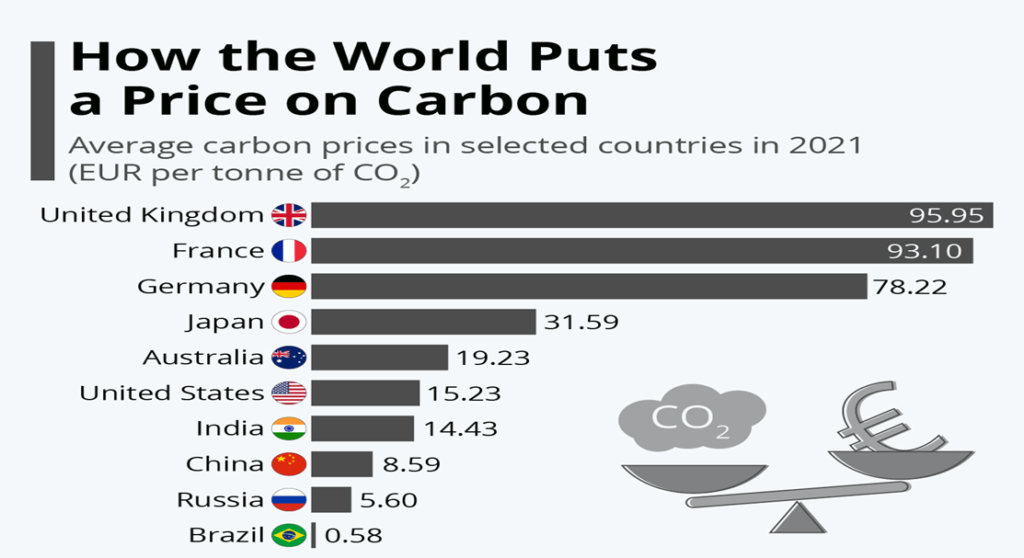Carbon pricing is an economic instrument that aims to capture the external costs of greenhouse gas (GHG) emissions by imposing a price on carbon dioxide (CO2) emitted. It is an effective tool to reduce emissions while generating revenue, which can be invested in clean energy sources or used to protect vulnerable consumers. India, as the current G-20 President, has a unique opportunity to lead the way in carbon pricing and open new avenues for decarbonisation.
What is Carbon Pricing?
Carbon pricing captures the external costs of GHG emissions, such as damage to crops, health care costs, and loss of property, and ties them to their sources through a price. Three ways of pricing carbon are a carbon tax, emissions trading system (ETS), and import tariff on carbon content.
The International Monetary Fund (IMF) has proposed price floors of $75, $50, and $25 a ton of carbon for the United States, China, and India, respectively, to achieve a 23% reduction in global emissions by 2030. Currently, 46 countries price carbon, covering only 30% of global emissions, and at an average price of only $6 a ton of carbon, a fraction of the estimated harm from the pollution.
Benefits of Carbon Pricing
Carbon pricing has economy-wide benefits in terms of avoiding damages and generating revenue. Carbon pricing signals a price for cleaner air, making investment in renewable energy more attractive. The EU, British Columbia, Canada, and Sweden have implemented carbon pricing, where the benefits outweighed the costs imposed on individual industries.
Carbon Pricing for India
India could find a carbon tax appealing as it can directly discourage fossil fuels while raising revenues for cleaner sources of energy or used to protect vulnerable consumers. In most countries, including India, fiscal policy has set in place the basic structures needed to implement a carbon tax, which can be woven into road-fuel taxes and extended to industry and agriculture. India could start with the IMF figure of $25 a ton, replacing the more inefficient scheme of petroleum taxes, which are not directly aimed at emissions.
Challenges in Implementing Carbon Pricing
The main obstacle is the argument by industrial firms about losing their competitive advantage to exporters from countries with a lower carbon price. All high, middle, and low-income countries need to set the same rate within each bracket to address this challenge. Communicating the idea of wins at the societal level, even in the presence of some individual producers’ losses, is vital.
Significance of Carbon Pricing
A high enough carbon tax across China, the U.S., India, Russia, and Japan alone, accounting for more than 60% of global effluents, could have a notable effect on global effluents and warming. It could pave the way to seeing decarbonisation as a winning development formula. As carbon pricing gains acceptance, the first movers will be the most competitive. India, as president at the G-20 summit, can play a lead role by tabling global carbon pricing in the existential fight against climate change.
Suggestions for Carbon Pricing
It might make sense to allow companies to use high-quality international carbon credits to offset up to a certain percentage of their taxable emissions. The EU excludes transport, Singapore provides vouchers for consumers hit by utility price rises, and California uses proceeds from the sales of carbon permits partly to subsidise purchases of electric cars. Exempting “emission-intensive trade-exposed” enterprises from the carbon tax could be replaced by output-based rebates.

Why In News
India has the opportunity to showcase its commitment to tackling climate change by leading the way in implementing effective carbon pricing policies. By doing so, India can encourage other G-20 nations to adopt similar measures and accelerate the transition to a low-carbon economy, which will ultimately benefit the entire planet.
MCQs about India’s Role in Carbon Pricing
-
What is carbon pricing?
A. An economic instrument that captures external costs of greenhouse gas emissions through a price on carbon dioxide emissions
B. A government program that provides subsidies to industries that reduce their greenhouse gas emissions
C. A marketing strategy used by clean energy companies to promote their products
D. A social initiative aimed at educating people about the dangers of greenhouse gas emissions
-
Which of the following is NOT a method of pricing carbon?
A. Carbon tax
B. Emissions trading system (ETS)
C. Import tariff on carbon content
D. Fossil fuel subsidy
-
What is the main obstacle in implementing carbon pricing?
A. The argument by industrial firms about losing their competitive advantage to exporters from countries with a lower carbon price
B. The lack of government support for clean energy sources
C. The difficulty in calculating the external costs of greenhouse gas emissions
D. The low level of public awareness about the need for decarbonization
Boost up your confidence by appearing our Weekly Current Affairs Multiple Choice Questions
![]()


